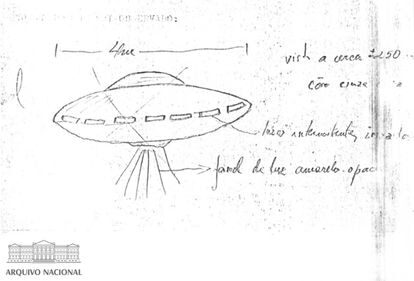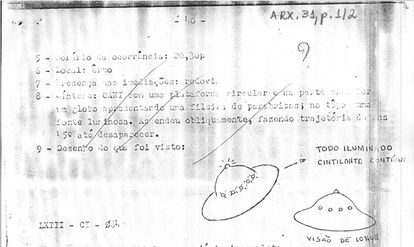
The minister - who appeared with the five military pilots and air traffic controllers who monitored the sightings - promised a detailed report about the frenetic hours within a month. It took him much longer, but finally, many years later, it was published. And anyone can read it, as it's been made available by the National Archives of Brazil, either in-person at the headquarters in Brasilia, or online.
NASA's recent decision to adopt a methodology to study what it calls "unidentified anomalous phenomena" has brought the UFO collection of the National Archives of Brazil to the fore. Prepared more than six decades ago by the Air Force, it contains some 20,000 pages of reports - many with confidential seals - and drawings, as well as audios, videos, photographs, correspondence and press clippings related to the 743 incidents recorded by Brazil's military between 1952 and 2016.
The US space agency has also announced the appointment of a director to lead the investigations... something that has a peculiar precedent in Brazil. From 1969 until 1972, a soldier - Commander Giberto Zani de Mello - oversaw a unit that was created within the Armed Forces to systematically monitor these unexplained phenomena that, for so many people, evoke the possibility of extraterrestrial life. It was called the Unidentified Aerial Object Investigation System (SIOANI) and its headquarters were based in a central neighborhood of São Paulo.
In the midst of the last Brazilian military dictatorship (1964-1985), the fact that a team of uniformed men were being asked by the high command to gather information about UFO-related events generated both alarm and curiosity. Officials from SIOANI traveled around the country to interview witnesses, writing up reports that included sketches - some of which portrayed a wide variety of flying saucer models - and producing a bulletin.
The Brazilian authorities emphasize - like their US colleagues - that UFOs aren't synonymous with spacecraft or aliens. Brasilia notes that the 743 archived records "don't mean that 743 flying saucers have been spotted, but rather, [they refer to] any object in the sky whose natural origin could not be immediately discovered. In other words, a UFO can be a drone, a star, a satellite, a weather balloon, or even a natural phenomenon."
Reports on the more than 700 unidentified flying objects investigated by the Air Force can be viewed (in-person or online) in the National Archives of Brazil.

The most famous UFO-related incident was what occurred on that Monday in 1986, when 21 UFOs invaded Brazilian airspace. It entered the history of ufology as "The Official Night of the UFOs." The military's subsequent report - in a dry tone - concluded the following about the hours that shocked the country: "The phenomena are solid and reflect, in some ways, intelligence, due to the ability [of the objects] to maintain distance from observers, as well as to fly in formation, [although they are] not necessarily manned."
The first to detect those luminous dots was an air traffic controller from São José dos Campos, the Brazilian city that hosts the National Institute for Space Research and other strategic facilities. Pilots who witnessed the events testified that the flying objects could move in a zigzag pattern, stop in the sky, make sharp right turns, change color and reach supersonic speeds.
The sound recordings of the frenetic conversations between the controllers and the pilots can be heard on the National Archives' website, which, from time to time, posts excerpts on social media. A ufologist named Marco Antonio Petit explained to BBC Brazil how the Brazilian military approached the phenomenon: "For years, I had the opportunity to interview high-ranking soldiers who told me: 'UFOs aren't shot down in Brazil because [we don't know] if they pose a threat. How will they react if they're attacked?"
As the UFOs were spotted during the Cold War, the uniformed men didn't rule out that some of the strange objects sighted over Brazil - a country with a tradition of neutrality - were spy satellites sent by either the Soviet Union or the United States.
The UFO collection is one of the most popular ones in the National Archives. Other major collections include the bulk of documentation on the last military dictatorship (1964-1985) - which is the most-consulted - as well as records on slavery, the arrival of white immigrants who replaced slave labor, Carnival, censorship, or the construction of Brasilia.
Brazil is a country where transparency is the norm: all official documents are public, except those declared secret. This is a policy that is often more advanced than developed nations in the Global North. And, thanks to that spirit of transparency (along with a formal request filed by the Brazilian Federation of Ufology), the archive on UFOs - gathered since the 1950s and guarded by the Air Force in Brasilia - began to be transferred to the National Archives of Brazil in 2008, during the second term of Luiz Inácio da Silva, who is currently serving his third term. They were subsequently made open to the public.
A little over a year ago, the Senate of Brazil invited local and foreign ufologists to a solemn session - as Mexico recently did - in an event that even included a supposed "non-human being." Those present in Brasilia welcomed the fact that many countries - such as Brazil, or even the Vatican - are partially opening their archives on this subject. The senator who organized the unique session - Eduardo Girão - was pleased that Brazil was the first country to officially admit that UFOs exist and have extraterrestrial origins.



Reader Comments
to our Newsletter